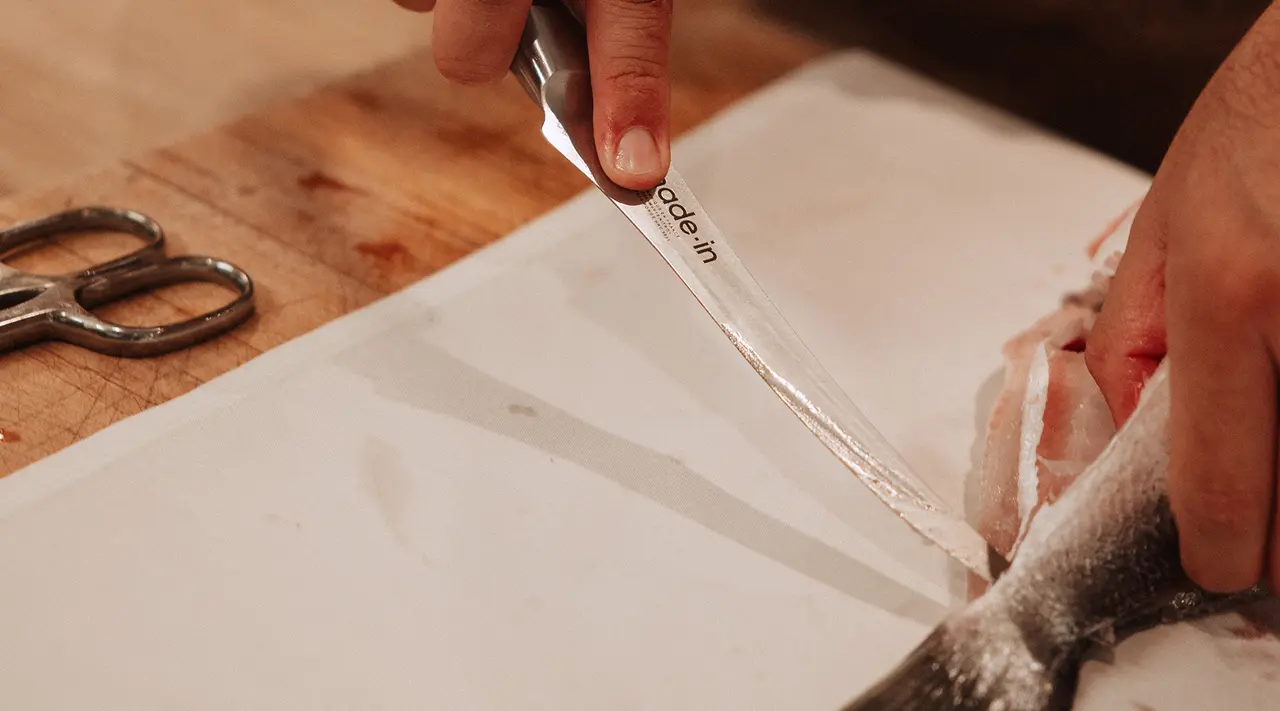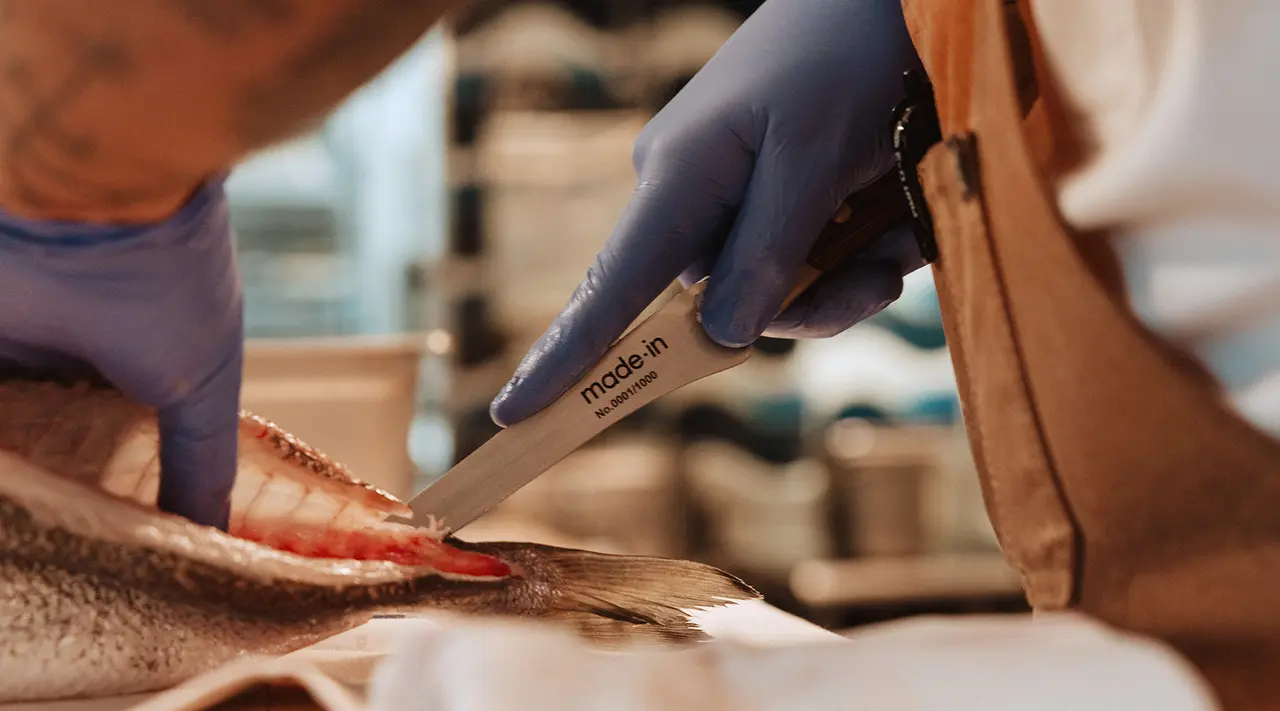Like breaking down a whole chicken, knowing how to turn a whole fresh fish into fillets or steaks is one of the most economical—not to mention impressive—ways of feeding yourself. And while a santoku or chef knife will get the job done, a fillet knife will get it done even more quickly and accurately due to its long, slim, flexible blade and tapered tip.
But what is a fillet knife used for (other than filleting, of course)? Read our full breakdown of this handy knife—its shape, its many uses, and how it differs from the very similar-looking boning knife—below.
What Is a Fillet Knife?

One of the defining characteristics of the fillet knife—other than its long, sabre-like profile—is its flexibility. Whereas a chef knife or santoku should feel stiff enough to haw through hard-skinned vegetables, the fillet knife’s relative bendiness helps it slip gracefully between skin or silverskin and delicate flesh, navigate around small bones, and, of course, break whole fish down into fillets or steaks. While some blades are bendier than others, however, your fillet knife should always feel stable—not like it’s going to permanently bend or break off.
Primary Uses of a Fillet Knife

Aside from the fillet knife’s eponymous purpose, it’s well-suited to light butchery tasks like breaking down chickens and small birds, slicing raw fish for sashimi, and breaking tenderloins down into steaks and chops. You can also use it for trimming and slicing fruits and vegetables like pineapples and melons.
Filleting Fish
Whether we’re talking about a tender, fatty piece of salmon or a whole swordfish loin, raw fish can easily bruise or tear if it’s handled too roughly. This is where a fillet knife comes in handy, allowing you to make long, near-frictionless strokes down the length of the fish, preserving its texture.
Deboning Meat
If you’re more of a fish person than a meat person, and you’re only planning on buying one knife, a fillet knife is the one to go for. While slightly longer and more flexible than a boning knife, which usually features a shorter, thicker blade, fillet knives can still serve double duty in many cases.
Preparing Delicate Cuts
Along with proteins, fillet knives are also surprisingly adept at carving up fruits and vegetables. With its flexibility and narrow, precise tip, the fillet knife can be used to trim and core pineapples, separate juicy melon from the rind, and slice citrus fruits without bruising them or wasting perfectly good flesh.
How to Use a Fillet Knife

Before you use your fillet knife (or any knife) for the first time, make sure to read up on proper knife safety, use a sturdy cutting board, and keep your blade nice and sharp.
Step-by-Step Instructions for Filleting Fish
- Make sure your fish is properly cleaned, gutted, scaled, and definned: you can usually ask your fishmonger to do this for you.
- Make your first cut: position the knife right behind the gills and then slice down until you hit bone, with the knife tip angled slightly down toward the head.
- Remove the fillet: using long, even strokes, drag the knife down the length of the fish from head to tail, right along the backbone. Flip fish and repeat on the other side.
- Skin and trim the fillet: position your fillet so that the thinner end is facing you. Gripping this end, make a small incision between the meat and the skin, then slowly cut down the length of the fillet with the blade angled down slightly to avoid cutting into the meat. Trim off any excess fat.
Benefits of Using a Fillet Knife
Here’s why the fillet knife is definitely worth adding to your knife roll.
Precision and Control
You know that super thin, flexible blade shape we’ve been talking up this whole time? Yeah, we’re mentioning it again. A fillet knife with the right balance of rigidity and flexibility offers the perfect amount of control for detailed butchery work, maneuvering easily around bones, tendons, and skin.
Versatility
A fillet knife may not be an all-purpose knife the way a chef knife is, but it is a multi-purpose knife. Again, we also love reaching for it when we need to core and slice fruits like pineapple (it’s great at removing those pesky eyes without hacking the flesh to bits); debone meat and poultry; and peel squashes and melons.
Improved Results
A high-quality, sharp fillet knife makes it easier to produce clean, uniform fish fillets, steaks, and slices of sashimi. If you’re splurging on expensive varieties like Dover sole and branzino (or even other delicious, affordable species like tilapia and flounder), this helps avoid waste and preserve the tender, flaky texture of the meat.
Care and Maintenance of Fillet Knives

Properly cleaning, sharpening, and storing your knife is crucial—both for your safety, and for the quality of your dish.
Follow Proper Cleaning Techniques
Even if it’s not your main knife, a fillet knife still deserves to be well-cared for. Always wash by hand; dry thoroughly with a microfiber cloth or soft dish cloth; and only use wooden, plastic, or composite cutting boards. For more details, check out our comprehensive guide to knife care.
Wood-handled knives, while they don’t require any special cleaning methods, do need occasional oiling to keep from drying out: read more on that in our dedicated post.
Stay on Top of Sharpening and Honing
Regular sharpening is a must for anyone who uses a knife at home While learning how to sharpen via whetstone (aka sharpening stone) isn’t terribly difficult, you can also opt to have your knife professionally sharpened a couple of times a year or so.
While different from sharpening, honing your knife—i.e. realigning the blade using a honing steel—makes your knife feel temporarily sharper. Honing only takes a minute or two, and you can do it as often as necessary.
Store Correctly
After cleaning and thoroughly drying your fillet knife, make sure it’s securely stored in a knife block, knife organizer, or sheath. Knives should never be left on the counter or kept loose in a drawer: this can damage or dull your blade, not to mention cause serious injury if you brush up against the blade by mistake.
Ready to Shop?
Fresh fish is already a top-tier culinary experience. Fresh fish that you’ve descaled, deboned, and artfully filleted by yourself, however? Practically nirvana. Of course, you don’t need to be a fishmonger to wield our new Fillet Knife: this full tang, fully forged blade offers just the right blend of flexibility and control for flawless fillets, perfectly deboned chickens, and more.
































